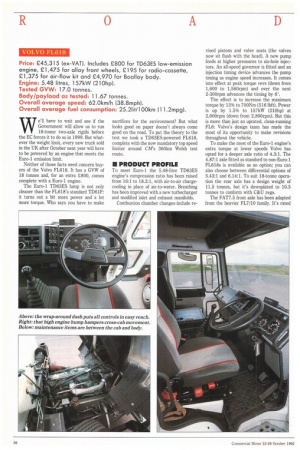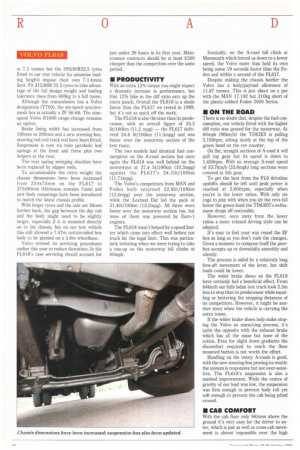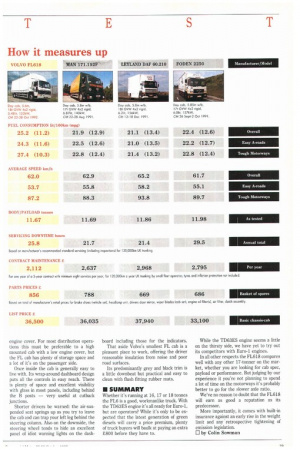Price: E45,315 (ex-VAT). Includes 2800 for TD63ES low-emission engine, 21,475
Page 28

Page 30

Page 31

If you've noticed an error in this article please click here to report it so we can fix it.
for alloy front wheels, 2195 for radio-cassette, £1,375 for air-flow kit and 24,970 for Boalloy body.
Engine: 5.48 litres, 157kW (210hp).
Tested GVW: 17.0 tonnes.
Body/payload as tested: 11.67 tonnes.
Overall average speed: 62.0km/h (38.8mph).
Overall average fuel consumption: 25.21it/100km (11.2mpg).
We'll have to wait and see if the Government will allow us to run 18-tonne two-axle rigids before the EC forces it to do so in 1999. But whatever the weight Limit, every new truck sold in the UK after October next year will have to be powered by an engine that meets the Euro-1 emission limit.
Neither of those facts need concern buyers of the Volvo FL618. It has a GVW of 18 tonnes and, for an extra £800, comes complete with a Euro-1 engine.
The Euro-1 TD63ES lump is not only cleaner than the FL618's standard TD61F: it turns out a bit more power and a lot more torque. Who says you have to make sacrifices for the environment? But what looks good on paper doesn't always come good on the road. To put the theory to the test we took a TD63ES-powered FL618, complete with the now mandatory top speed limiter around CM's 360km Welsh test route.
• PRODUCT PROFILE
To meet Euro-1 the 5.48-litre TD63ES engine's compression ratio has been raised from 16:1 to 18.3:1, with air-to-air chargecooling in place of air-to-water. Breathing has been improved with a new turbocharger and modified inlet and exhaust manifolds.
Combustion chamber changes include re
vised pistons and valve seats (the valves now sit flush with the head). A new pump feeds at higher pressures to six-hole injectors. An all-speed governor is fitted and an injection timing device advances the pump timing as engine speed increases. It comes into effect at peak torque revs (down from 1,600 to 1,560rpm) and over the next 2-300rpm advances the timing by 6°.
The effect is to increase the maximum torque by 13% to 700Nm (516 lbft). Power is up by 1.5% to 157kW (210hp) at 2,600rpm (down from 2,800rpm). But this is more than just an uprated, clean-running FL6: Volvo's design team has made the most of its opportunity to make revisions throughout the vehicle.
To make the most of the Euro-1 engine's extra torque at lower speeds Volvo has opted for a deeper axle ratio of 4.3:1. The 4.87:1 axle fitted as standard to non-Euro-1 FL618s is available as an option; you can also choose between differential options of 5.43:1 and 6.14:1. To suit 18-tonne operation the rear axle has a design weight of 11.5 tonnes, but it's downplated to 10.5 tonnes to conform with C&U regs.
The FAT7.5 front axle has been adapted from the heavier FL7/10 family. It's rated at 7.5 tonnes but the 295/80R22.5 tyres fitted to our test vehicle (to minimise loading height) impose their own 7.1-tonne limit. Fit 315/80R 22.5 tyres to take advantage of the full design weight and loading tolerance rises from 600kg to a full tonne.
Although the transmission has a Volvo designation (T700), the six-speed synchromesh box is actually a ZF 56-66. The ninespeed Volvo R1000 range-change remains an option.
Brake lining width has increased from 180mm to 200mm and a new steering box, steering rod and track rod have been fitted. Suspension is now via twin parabolic leaf springs at the front and three plus two helpers at the rear.
The rear spring swinging shackles have been replaced by slipper ends.
To accommodate the extra weight the chassis dimensions have been increased from 254x75mm on the FL617 to 275x90mm (thickness remains 7mm) and new body mountings have been introduced to match the latest chassis profile.
With larger tyres and the axle set 34mm further back, the gap between the day cab and the body might need to be slightly larger, especially if it is mounted directly on to the chassis, but on our test vehicle this still allowed a 7.47m curtain-sided box body to be planted on a 5.6m wheelbase.
Volvo revised its servicing procedures earlier this year to reduce downtime. In the FL618's case servicing should account for just under 26 hours in its first year. Maintenance contracts should be at least £500 cheaper than the competition over the same period.
111 PRODUCTIVITY
With an extra 13% torque you might expect a dramatic increase in performance, but that 12% hike in the diff ratio eats up the extra punch. Overall the FL618 is a shade faster than the FL617 we tested in 1989, but it's not as quick off the mark.
The FL618 is also thirstier than its predecessor, with an overall figure of 25.2 lit/100km (11.2 mpg) — the FL617 delivered 24.6 lit/100km (11.5mpg) and was faster over the motorway section of the test route.
The two models had identical fuel consumption on the A-road section but once again the FL618 was well behind on the motorways at 27.4 lit/100km (10.3mpg) against the FL617's 24.11it/100km (11.71mpg).
The Volvo's competitors from MAN and Foden both returned 22.81it/100km (12.4mpg) over the motorway section, while the Leyland Daf led the pack at 21.4lit/100km (13.2mpg). All three were faster over the motorway section too, but none of them was powered by Euro-1 engines.
The FL618 wasn't helped by a speed limiter which came into effect well before our truck hit the legal limit. This was particularly irritating when we were trying to take a run-up on the motorway hill climbs at 60mph. Ironically, on the A-road hill climb at Monmouth which forced us down to a lower speed, the Volvo more than held its own being some 19 seconds faster than the Foden and within a second of the FL617.
Despite making the chassis beefier the Volvo has a body/payload allowance of 11.67 tonnes. This is just about on a par with the MAN 17.192 but 310kg short of the plastic-cabbed Foden 2000 Series.
• ON THE ROAD
There is no doubt that, despite the fuel consumption, our vehicle fitted with the higher cliff ratio was geared for the motorway. At 60mph (96km/h) the TD63ES is pulling 2,150rpm, sitting nicely at the top of the green band on the rev counter.
On flat, straight sections of A-road it will pull top gear but its speed is down to 1,450rpm. With an average A-road speed of 53.71cm/h (33.6mph) long sections were covered in 5th gear.
To get the best from the FL6 driveline upshifts should be left until peak power is reached at 2,600rpm, especially when you're in the lower ratios. With only six cogs to play with when you let the revs fall below the green band the TD63ES's enthusiasm drops off noticeably.
However, once away from the lower ratios a more relaxed driving style can be adopted.
It's easy to find your way round the ZF box as long as you don't rush the changes. Given a moment to compose itself the gearbox accepts up or downshifts smoothly and silently.
The process is aided by a relatively long fore-aft movement of the lever, but shift loads could be lower.
The wider brake shoes on the FL618 have certainly had a beneficial effect. From 64km/h our fully laden test truck took 2.5m less to stop than its predecessor while equalling or bettering the stopping distances of its competitors. However, it might be another story when the vehicle is carrying the extra tonne.
If the wider brake shoes help make stoping the Volvo an unexciting process, it's quite the opposite with the exhaust brake which has all the noise but none of the action. Even for slight down gradients the discomfort required to reach the floor mounted button is not worth the effort.
Handling on the twisty A-roads is good, with the new steering box proving its worth: the system is responsive but not over-sensitive. The FL618's suspension is also a marked improvement. While the centre of gravity of our load was low, the suspension was firm enough to prevent body roll yet soft enough to prevent the cab being jolted around.
• CAB COMFORT
With the cab floor only 965mm above the ground it's very easy for the driver to enter, which is just as well as cross-cab movement is almost impossible over the high engine cover. For most distribution operations this must be preferable to a high mounted cab with a low engine cover, but the FL cab has plenty of storage space and a lot of it's on the passenger side.
Once inside the cab is generally easy to live with. Its wrap-around dashboard design puts all the controls in easy reach. There is plenty of space and excellent visibility with glass in most panels, including behind the B posts very useful at cutback junctions.
Shorter drivers be warned: the air-suspended seat springs up as you try to leave the cab and can trap your left leg behind the steering column. Also on the downside, the steering wheel tends to hide an excellent panel of idiot warning lights on the dash
board including those for the indicators.
That aside Volvo's smallest FL cab is a pleasant place to work, offering the driver reasonable insulation from noise and poor road surfaces.
Its predominantly grey and black trim is a little downbeat but practical and easy to clean with flush fitting rubber mats.
• SUMMARY
Whether it's running at 16, 17 or 18 tonnes the FL6 is a good, workmanlike truck. With the TD63ES engine it's all ready for Euro-1, but are operators? While it's only to be expected that the latest generation of green diesels will carry a price premium, plenty of truck buyers will baulk at paying an extra £800 before they have to.
While the TD63ES engine seems a little on the thirsty side, we have yet to try out its competitors with Euro-1 engines.
In all other respects the FL618 compares well with any other 17-tonner on the market, whether you are looking for cab spec, payload or performance. But judging by our experience it you're not planning to spend a lot of time on the motorways it's probably better to go for the slower axle ratio.
We've no reason to doubt that the FL618 will earn as good a reputation as its predecessor.
More importantly, it comes with built-in insurance against an early rise in the weight limit and any retrospective tightening of emission legislation.
El by Colin Sowman












































































